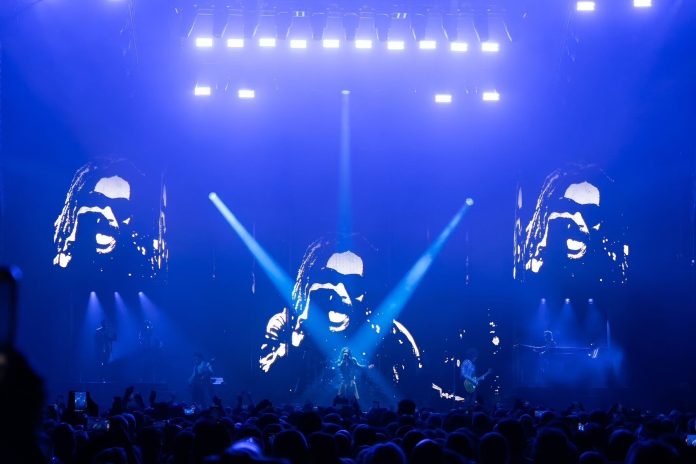
Having successfully completed its European run of shows this summer, Lenny Kravitz’s Blue Electric Light Tour is preparing for its Americas leg, which will see the rock legend perform 14 shows during the final quarter of 2024. In this well-earned breathing space, MA spoke to Lighting Designer, Bryan Barancik and programmer Felix Peralta about their use of the grandMA3 for these shows.
Barancik’s extraordinary lighting design career so far has featured some big-name clients, including Alicia Keys, Eagles, Christina Aguilera, Cardi B, and Cher, but it’s with Kravitz that he’s been focusing his talents throughout much of 2024. With an interest in the technical side of lighting while at college, he set out on his future path when he “decided theatre design wasn’t as appealing as music”!
He worked his way up and through the various platforms and tools of the period, eventually to MA. “I was doing a mix of design and programming, both programming my own shows and for others including Steve Cohen and Baz Halpin,” he recalled. “By the time I transitioned to MA, grandMA2 was becoming more popular, although at the time still running software of the first grandMA series.”
Fast-forward to grandMA3, and Barancik’s experience has been “smooth sailing” so far, especially since – as he admits – “I haven’t programmed on grandMA3 just yet!”
Cue Felix Peralta – lighting programmer and an accomplished designer in his own right. Peralta has a long history with MA and was hands-on with the grandMA3 system for this tour. “I’ve been running grandMA3 software exclusively now for almost two years,” he said. “I’ve been on the MA platform since 1998 and have never looked back. Hands down, it’s the most stable and robust system for the touring world.”
This production’s set design is the work of none other than Ray Winkler of Stufish. “This was my first time working with Stufish as a design collaborator, which worked out well,” says Barancik. “I’ve worked with Lenny Kravitz for many years, so I understood his visual and musical tastes and interests overall. We went through several concepts and designs before landing on something that resonated with Lenny most of all, and could be shoehorned into European festivals.”
So how did the grandMA3 system help with this process? Peralta said: “While we haven’t fully adopted the Recipes workflow, I’d say the power of the Selection Grid, the world of Phasers, the Multi User environments – all allow us to work quickly and efficiently throughout our process.” He also praises the “robust” stability of the platform, as well as the flexibility offered by the onPC access via his MAC. “That’s a great tool,” he says, “especially when making adjustments on the go”.
The ability to use GDTF data and MVR files plays a valuable role in smoothing the process. “The MVR import has become an important part of our show file workflow,” said Peralta. “It all starts there. I use the MVR to bring in fixture x, y, z [position in 3D space] and patch details. I’ll always try and use as many solid GDTF fixture profiles as possible.”
Peralta finds the accuracy in visualisations to be one of the more valuable assets of GDTF data. Also, he said: “A successful MVR import gives us the ability to streamline workflows, and allows for better collaboration, as we’re all looking at the same accurate information. It ultimately saves time and money in the production process.”
And the best time-saving feature in grandMA3? “I would say the best feature is Felix himself!” said Barancik. “The Selection Grid in grandMA3 is hands-down the best feature in saving me time.”
Expanding on this, he said: “I’ll always create a handful of specific Selection Grid ‘groups’ per fixture type – one group that reflects how the lights are living in x, y, and z, and two groups that are linearised from fixture IDs and from Left to Right. I’ll create a ‘Blocks’ Selection Grid group in ‘y’, to create a custom A/B or Odd/Even type of effect, and another ‘Blocks’ group in ‘y’ will be to affect from truss to truss – i.e. Upstage Truss, MS Truss, DS Truss, Floor – all big system blocks. Once I create these important handful of groups, I’m off to the races with my creative senses, creating discrete timings, special FX phasers etcetera.”
Barancik’s design includes 75 active universes and over 60,000 parameters in total – all programmed in Mode 3. Alongside Barancik and Peralta, the lighting team includes JoeMac McGinley (associate lighting designer), Mike Gionfriddo (lighting director) and Chema Hernandez (media).
The team is using two grandMA3 full-size and one grandMA3 light console, running software V2.0.2.0. There are also five grandMA3 processing unit XLs (the 2U rack-mount brain that provides more parameters and frame-synchronous calculation across the MA-Net3 environment). The system is completed by 11 grandMA3 8Port Nodes, the 1U Ethernet-to-DMX converter designed to synchronously output 8 DMX universes from any grandMA3 session.
Peralta added: “Our AllStar tour lighting crew has been a huge part of the stability of our system and network. They’re a great international group of lighting professionals, who gave their best efforts day in and day out, in both festival and ‘solo’ show situations.” Led by crew chief Florian von Derschau, these included Rouven Dietrich (FOH systems lead tech) and lighting techs Jake Harrison, Jan Ludwig, Bryn Jones, Markus Laps and Tom Begley. A new US-based crew will take over for the Americas leg.
So what’s next? “The rest of the year is mostly Lenny Kravitz, so grandMA3 continues,” concluded Barancik. “We’re also building the upcoming Maxwell tour. Other shows in the near future include the Global Citizen NYC Concert Event, as well as the Rock & Roll Hall of Fame Induction Ceremony in Cleveland – all powered by grandMA3 software.”




